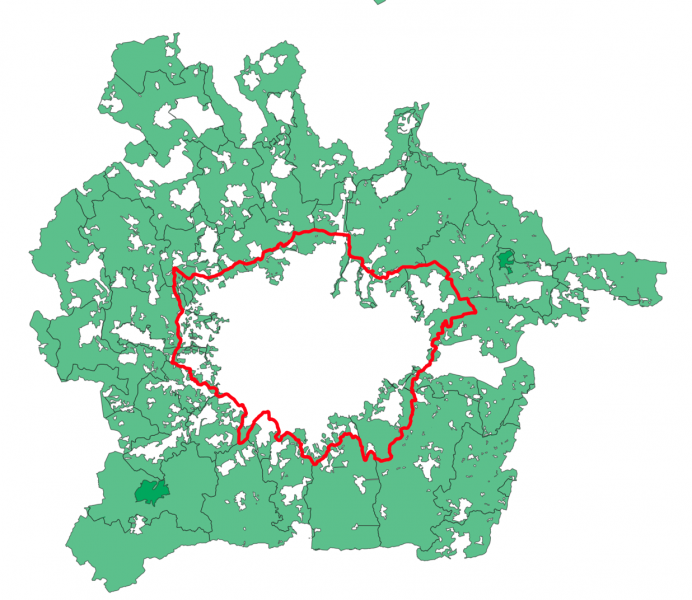Guy Shrubsole12 Jun 2019
When was the last time you consciously took a trip into the Green Belt? Millions of us live in cities surrounded by Green Belt designations: areas of land set aside specifically not to be developed, but rather to remain open countryside. Green Belts today cover 13% of England, a huge 1.5 million hectares of land.
Yet despite living in London for the past 7 years, I have to say honestly that I’ve rarely felt drawn to visit the vast expanse of Green Belt that encircles the metropolis — even if I’ve unwittingly strayed into it on trips out of the Big Smog. ‘Let’s go for a trip to the Green Belt’ isn’t a phrase in common parlance, it seems — far less, anyway, than ‘let’s visit a National Park’ or ‘let’s go to a nature reserve’. Partly this is to do with the purpose of the Green Belt — it’s a largely negative planning designation, designed to constrain urban sprawl, rather than actively encourage a particular form of land use or protect an extraordinary landscape. As a result, much Green Belt land consists of rather ordinary farmland, scattered with golf courses and the occasional Country Park.
In recent years, as the housing crisis has gathered pace, the Green Belt has come under increasing attack for supposedly constraining house-building — particularly by free-market think tanks who relish the prospect of ripping up the ‘red tape’ of the planning system. In reality, opening up the Green Belt to development would do almost nothing to impact house prices: rather, it would just hand a massive windfall to landowners in the Green Belt as they saw the price of their land skyrocket. Even if we built all over the Green Belt, the resulting carbon emissions and air pollution from the added roads and extra commuting would be unimaginable. No: medium-density cities, coupled with land value capture to encourage affordable housing, is the way forward.
London’s green belt. The red line is the GLA boundary.
Filled to bursting with trees, woods and nature reserves: a new vision
But that still leaves our major cities with large hinterlands of Green Belts that are not, in all honesty, particularly green. Some conservation groups like CPRE defend the Green Belt for its existing recreational value — and it’s true that many people do already make good use of Green Belt land for walking and cycling. It’s also true that the woods and farms preserved by the Green Belt can and do have an existing value for food production and nature. But is it really the best we can do? Just 13.6% of Green Belt land in England comprises broadleaf and mixed woodland — barely higher than the UK average. And only 3.5% of the Green Belt is Open Access land, over which we have a Right to Roam. Surely such land, lying on the doorstep of millions of nature-deprived city-dwellers, ought to be filled to bursting with trees, woods and nature reserves that we can all access.
That’s the vision that Friends of the Earth have started exploring, as part of our wider ambition to see UK woodland cover double by 2045. We need to plant lots more trees — correction, a shedload more trees (technical term) — in order to get the country to net zero emissions, combat the climate emergency and create more space for nature. So, why not start on people’s doorsteps — by planting lots more trees in the Green Belt?
Who owns the land and what are the barriers ? An invitation to join us
One avenue we’ve been investigating is to uncover land in the Green Belt owned by councils. It turns out that some London boroughs own a surprisingly large amount of land in the metropolitan Green Belt — a historical quirk, it appears, dating back to a drive by councils to acquire land on the urban fringe in the 1930s to protect it from development, prior to the creation of the national planning system and ‘official’ Green Belt designations. Much of this land has remained in council hands ever since. The Greater London Authority (GLA) calculates that around 2,250 hectares of Green Belt land within its boundaries belongs to local authorities. That’s about 7 times the size of Hampstead Heath: imagine that amount of new woodland and parkland being created on London’s edge!
Looking at other Green Belts — around Bristol, Oxford, and Manchester — we’ve identified other expanses of land owned by councils, though none so extensive as the areas owned by London authorities. But our investigations have also flagged up other major landowners in these different Green Belts who might yet be persuaded to plant more trees: the Oxford Colleges, for instance, own most of the land surrounding Oxford.
Of course, there are many obstacles to increasing the number of trees in the Green Belt. Much of it is currently used as farmland; for the tenant farmers who farm it it’s their livelihood, whilst the landowners who let it to them get income in the form of rent. Changing the pattern of land use will take time, a shift in incentives — whether public grants, private philanthropy or community crowdfunding — and many more conversations. It requires new models too: forms of regenerative agriculture that don’t pit farming against nature. We’re now starting those conversations with various councils, farmers and landowners — seeking to understand what it would take to overcome those barriers, and see the Green Belt turn a brighter shade of green.
If you’ve got an idea for really greening the green belt, or would just like to know more, get in touch.
Check out Friends of the Earth's Trees campaign and tell the government to double tree cover in the UK.


